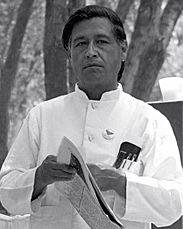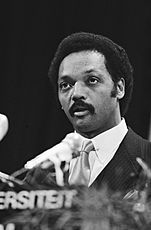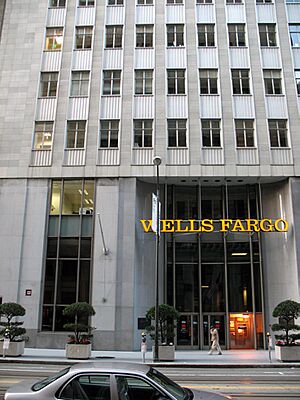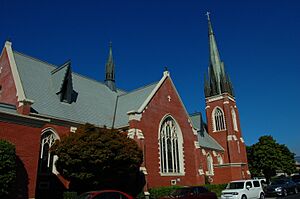1985–1987 Watsonville Cannery strike facts for kids
Quick facts for kids 1985–1987 Watsonville Cannery strike |
|||
|---|---|---|---|
| Date | September 9, 1985 – March 11, 1987 (1 year, 6 months and 2 days) |
||
| Location |
Watsonville, California, United States
|
||
| Caused by | Disagreements over the terms of a new labor contract | ||
| Goals | Union sought to prevent cuts in wages and benefits | ||
| Methods |
|
||
| Resulted in | Union and companies agreed to new industry-wide labor contract that preserved employee benefits, but included wage cuts | ||
| Parties to the civil conflict | |||
|
|||
The 1985–1987 Watsonville Cannery strike was a big worker strike that happened in Watsonville, California. More than 1,000 people who worked at two large food processing factories stopped working. These factories were owned by Watsonville Canning and Richard A. Shaw Inc., which were two of the biggest companies making frozen food in the United States. The workers were all part of a local union called International Brotherhood of Teamsters (IBT) Local 912. The strike started on September 9, 1985, and lasted for about 18 months, finally ending on March 11, 1987.
Watsonville was known as the "frozen food capital of the world" because it had many food processing plants. These plants had agreements with Local 912, which represented thousands of workers. By the 1980s, many of these workers were Latinos who had moved from Mexico. Around this time, the food processing business became less profitable. In 1982, Watsonville Canning lowered hourly wages for its union workers. In 1985, their contract ended, and both Watsonville Canning and Richard A. Shaw Inc. wanted to cut wages and benefits even more. The union said no. So, on September 9, 1985, the workers from both companies went on strike and started picketing (walking outside the factories with signs).
The strike got a lot of help from the local Latino community and groups like the League of United Latin American Citizens. Important civil rights leaders like Cesar Chavez and Jesse Jackson also supported the workers. They saw the strike as part of a bigger fight for civil rights for Latinos. The workers even elected their own Strike Committee to manage the strike every day. In February 1986, Shaw and Local 912 agreed to a new hourly wage, which became the standard for the industry. But the strike against Watsonville Canning continued. In August, the company tried to remove the union through an election, but they failed. Watsonville Canning then went bankrupt and was sold. A new agreement was made in March 1987, which set wages to the industry standard but cut medical benefits. The union said the strike was over, but some workers kept striking for another week until the company agreed to include medical benefits. The strike finally ended on March 11, 1987.
Many people who study labor history say this strike was one of the few successful ones in the United States during the 1980s. It was a rare win for workers when many companies were trying to weaken unions. The strike also led to more political activity from the Latino community in Watsonville. Oscar Rios, who helped organize the strike, later became the city's first Latino mayor. However, after the strike, most of the big food processing companies left Watsonville, and by 2000, only one frozen food plant was left in the city.
What Caused the Strike?
Watsonville's Food Industry
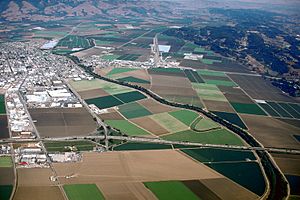
Watsonville is a city about 80 miles (129 km) south of San Francisco. It became a big center for food processing in the early 1900s. This was because it was close to the Pajaro Valley and Salinas Valley, which grew a lot of vegetables like broccoli and cauliflower. By the 1950s, companies in Watsonville started freezing food instead of canning it. The city became known as the "frozen food capital of the world." By 1986, Watsonville processed about 40 percent of the frozen broccoli and other vegetables in the United States.
By the mid-1980s, two companies, Watsonville Canning Company and Richard A. Shaw Inc., were the biggest players. They made about 80 percent of Watsonville's frozen food. Watsonville Canning was the largest frozen food processor in the United States. It employed about 5,000 people and processed half of the country's frozen vegetables.
Latino Community in Watsonville
In 1900, only a small number of people in Watsonville were from Mexico. Many food processing workers were from Portugal or Slavic countries. But as farming grew, more Mexican immigrants came to the area for work. Starting in the 1960s, the industry hired more women, especially Mexican immigrants. Watsonville became a place where many Latino people settled, finding more stable jobs than farmworkers. By the 1980s, Latinos made up most of Watsonville's population. About nine out of ten frozen food workers in the city were Latino.
Even though Latinos were the majority, white Americans held most of the power in the city's economy and politics. There was unfair treatment against Latinos, especially with housing. In 1969, some Latino students at Watsonville High School even walked out of classes to demand more Latino teachers. By 1985, most city leaders were white, and only one city council member was Latino.
Workers and Their Union
In the 1930s and 1940s, labor unions started organizing food processing workers. The International Brotherhood of Teamsters (IBT) became the main union in the industry. In 1952, IBT Local 912 was formed in Watsonville to represent cannery workers. By 1986, it represented almost all 4,000 food processing workers in the city. This union local was very close to the business owners. Some people even called it a "company union" because its leaders seemed to work more with the companies than for the workers.
By 1985, about 70 percent of Local 912 members were Latino. However, the union's leaders were mostly white and didn't always understand the members' needs. Union meetings were only in English, and for a long time, only one leader spoke Spanish. Also, most union members were women, but they were not represented in the leadership. Despite these problems, the union had managed to get good wages and employee benefits for workers, with hourly pay up to $7.05 for most workers.
Changes in the Industry
In the 1970s, California had a "virtual monopoly" on processing certain vegetables. But by the 1980s, things changed. More frozen foods were coming from other countries like Mexico and Guatemala, where labor costs were much lower. Also, people started wanting more fresh food instead of frozen or canned food. Many canneries in California closed, and thousands of jobs were lost.
Wage Cuts at Watsonville Canning
To deal with these changes, Watsonville companies wanted to change their agreements with Local 912. In 1982, Watsonville Canning cut hourly wages from $7.06 to $6.66. The company said it needed to do this to avoid going bankrupt. This cut gave Watsonville Canning an advantage over other plants. Soon, other food processors also asked the union for similar wage cuts.
Contract Talks
In early 1985, Watsonville Canning and the union started talking about a new contract. The company wanted a system where current employees would keep their $6.66 hourly pay, but new hires would start at only $4.25. The union members voted against this in August and wanted their wages to go back up to $7.06.
Watsonville Canning made 22 different offers, but all of them included cuts to wages and benefits. The company eventually set a base hourly pay of $4.75 for existing employees and $4.25 for new hires. They also removed 54 employee benefits, including cuts to healthcare and vacation time. The company also made workers produce more food faster, which led to more work accidents and some workers being fired. Workers were even told they couldn't use the restroom outside of their scheduled breaks. Workers felt these changes were unfair.
Richard A. Shaw also wanted similar cuts, proposing to lower hourly pay from $7.06 to $6.66 and cut 25 employee benefits. The companies started getting ready for a strike. Watsonville Canning stockpiled its products and got a large loan from Wells Fargo. Union officials believed the companies were trying to force a strike so they could hire new workers and get rid of the union.
Local 912 was not ready for a strike. Union leaders didn't want a strike, and the union didn't have a special fund to help workers during a strike. But on September 6, 1985, the workers voted to strike. They had been working without a contract for three months. The strike would be the first in Watsonville in 37 years and would involve over 1,000 workers, mostly Latina women, many of whom were single mothers.
The Strike Begins
First Days of the Strike
The strike began on Monday, September 9, 1985. Workers gathered at the union hall, got their picket signs, and went to the factory gates. At Watsonville Canning, the picket line stretched for eight city blocks. Many signs were in both English and Spanish, and many workers brought their children. The company and the district attorney quickly asked a judge to limit the picketing. The judge issued a temporary restraining order that same day, allowing only a few pickets at each gate and limiting how close they could be to each other. This made the strike much harder.
The Watsonville City Council increased funding for their police department, and officers worked long shifts to keep an eye on the picketing. Police arrested several strikers for breaking the restraining order. Watsonville Canning even put up more fences to reduce the number of pickets allowed. The company also mailed workers their last paychecks instead of letting them pick them up at the plant. On September 20, about 17 students from Watsonville High School were arrested for joining the picketers. Police in riot gear then broke up the crowd. The judge later made the restraining order a permanent injunction.
Community Support for Strikers
To help with lost wages, strikers received only $55 a week in strike pay, which was much less than their usual $250. They also lost their benefits. Many families relied on extended family and local food banks. Local grocery stores sometimes gave strikers credit, and some landlords delayed rent payments. Many supporters saw the strike as an attack by the white leaders on the Latino community.
Two support groups were formed to help the strike, and donations came from various Chicano groups. Students and activists from nearby universities also helped.
Teamsters for a Democratic Union
The Teamsters for a Democratic Union (TDU), a group within the IBT that wanted the union to be more active and led by its members, also got involved. The TDU had pushed for union meetings to be held in both English and Spanish. During the strike, the TDU tried to help lead the strike and pushed for weekly strike meetings and higher strike pay.
Strikebreakers
To keep their factories running, the companies hired strikebreakers (replacement workers) soon after the strike began. These workers were paid a little over $5 an hour, with no benefits or guaranteed jobs. For the first two months, the plants ran with only about 80 to 100 strikebreakers, instead of 1,000 to 2,000 regular employees. This meant production was much lower. Many replacement workers quit after only a few weeks. However, by September 1986, Watsonville Canning had about 900 replacement workers.
Police often went with the strikebreakers to and from the plants because picketers would try to scare them, sometimes spitting and calling them "esquiroles" (Spanish for "scab"). There were some violent incidents, including attacks on strikebreakers and their cars. One striker was arrested for trying to throw a Molotov cocktail at a bus carrying strikebreakers. Three cars owned by company executives were destroyed, and there were more cases of arson (setting fires on purpose). Two fires at Watsonville Canning properties caused about $1 million in damages. In total, four arsons caused about $2 million in damages. Despite this, no one was seriously hurt.
Late 1985 Events
On October 6, about 3,000 supporters marched to the Watsonville Canning plant for a "Solidarity Day" rally. A few days later, on October 15, about 400 strikers elected their own Strike Committee. This committee, made of workers from both plants, managed the strike's daily activities, like 24-hour picketing and giving out food. Gloria Betancourt, one of the workers elected, said they formed the committee because they didn't trust the union officials anymore.
That same month, Watsonville Canning offered a base hourly pay of $5.05 and said they would prefer to keep the replacement workers over the striking workers. On October 28, 1985, union members voted 800 to 1 to reject this offer. On November 3, another rally drew about 3,000 supporters. In December, Local 912 held elections. More active and determined candidates ran against the current leaders. While Gloria Betancourt did not win her bid for president, other determined members were elected. The union president, Richard King, was not reelected.
Shaw Company Settles
In February 1986, after several months, the workers at Richard A. Shaw reached an agreement with the company. The strike ended for them on February 14. The workers accepted an hourly pay rate of $5.85. This was higher than what Shaw had first offered, but still lower than their old pay. This agreement affected about 900 workers, who took a 17 percent pay cut. This new wage became the standard for the industry.
Early 1986 Events
On International Women's Day (March 8), another rally drew about 4,000 supporters. Political activist Jesse Jackson gave a speech there. Local 912 also connected with other striking workers across the United States, like flight attendants striking against Trans World Airlines. They held joint rallies to support each other. Gloria Betancourt said they learned from other strikers about what worked and what didn't.
On June 29, the Strike Committee held another big rally in Watsonville with over 4,000 people, including members of Chicano organizations and the United Farm Workers (UFW). Jesse Jackson, who was running for president, spoke again. He compared the strike to the Selma to Montgomery marches during the civil rights movement. Jackson was a strong national supporter of the strikers.
Union Targets Wells Fargo
Around mid-1986, Local 912 started focusing on Wells Fargo bank. This was because Wells Fargo was a major financial supporter of Watsonville Canning. Cesar Chavez had suggested this idea in November 1985. In May 1986, the IBT voted to pressure Wells Fargo. They wanted labor unions in northern California to take their money out of Wells Fargo if the strike didn't end well for the union. However, the international union didn't do much active campaigning against Wells Fargo.
By this time, many strikers had found other jobs or even moved away from Watsonville. In August 1986, Watsonville Canning's owner, Mort Console, asked the National Labor Relations Board (NLRB) to hold a vote to remove Local 912 as the workers' union. Both striking union members and non-striking workers would vote. Local 912 worked hard to get union members, even those who had moved far away, to come back and vote against removing the union. Console hired more strikebreakers to increase the non-union votes. In a close election, the union members won, and the effort to remove the union failed.
Watsonville Canning Sold
After the union decertification vote failed, Console's financial problems got worse. Watsonville Canning closed for 11 days. Console was over $30 million in debt. The Strike Committee then pushed the IBT to take all their money out of Wells Fargo. The Chicano activist group MEChA started its own boycott of Wells Fargo. In January 1987, rallies were held at eight Wells Fargo branches. By September, the Los Angeles Times reported that the local union had been running a "corporate campaign" against Watsonville Canning's lenders. In December 1986, Console closed the plant for a month. Two months later, Wells Fargo said Console had failed to pay his loans. To avoid bankruptcy, Console had to sell the plant.
A new company called Norcal Frozen Foods bought the plant in February 1987. On February 28, 400 strikers elected a new committee to make a deal with the new owners. On March 6, a temporary agreement was reached to end the strike. The deal would set hourly wages at $5.85, the industry standard. However, many union members were against the agreement because it would take away their medical benefits. The union members voted to wait a week before approving the contract. But the IBT announced the strike was over, stopped strike benefits, and locked members out of the union hall. Without IBT approval, Local 912 members continued their strike on their own, which is called a wildcat strike.
Hunger Strike and End of Strike
Six women, including Gloria Betancourt, started a hunger strike to protest the lack of medical benefits. The new plant owners said that any employees who didn't come to work on Monday, March 9, would lose their seniority rights (their right to be hired back first based on how long they worked there). On March 9, hundreds of strikers protested outside the plant, demanding their medical benefits back. Only a few dozen workers went to work, keeping the plant mostly closed.
The next day, the protesters started a religious procession. More than 20 women and several men walked on their knees for four city blocks to St. Patrick's Catholic Church. They prayed to Our Lady of Guadalupe, and their leader chanted, "As long as God is in Heaven, I will never give up." A special church mass was held, where the local priest told the strikers to keep protesting until their medical benefits were part of the contract. This type of walk had been used by UFW members in a strike years before. Later that night, talks between Local 912 and the company started again.
On March 11, a new contract that kept the workers' medical benefits was approved by a vote of 543 to 21. The three-year contract also kept their seniority rights and gave them "strike amnesty" (meaning they wouldn't be punished for striking). For pay, workers accepted the new industry standard of $5.85, but they could earn up to $6.61 with an incentive plan. The contract also allowed for new talks about pay in 1988 and 1989. To celebrate the end of the strike, union members held a parade down Watsonville's Main Street. Even though they got their benefits, many strikers saw the outcome as a compromise, not a full victory, because of the wage cut. Gloria Betancourt said, "It was not what we wanted, but it was still a victory."
What Happened After the Strike?
Impact in Watsonville
The IBT spent about $5 million on strike benefits. The city government lost about $1 million due to police overtime and lost sales. The strike had a big impact on Watsonville, with increased violence and economic problems. Many strikers saw their savings disappear, and some moved away from Watsonville permanently.
After the strike, the plant reopened with a small number of former strikers hired back based on their seniority. However, many growers who used to work with Watsonville Canning had made deals with other plants during the strike, so the plant didn't produce as much. Norcal Frozen Foods eventually went out of business, and hundreds of jobs were lost.
In the years after the strike, more food processing plants in Watsonville closed and moved their operations to Mexico. By 2000, only one frozen food plant was left in the city, employing about 400 people. As a result, the unemployment rate in Watsonville stayed high compared to the rest of California.
Political Changes in Watsonville
The strike happened at the same time as a court case, Gomez v. City of Watsonville, which was about the lack of Latino representation in Watsonville's city government. The court's decision led to a new election system that better represented the city's different groups. In the years that followed, several Latinos were elected to the city council and other government jobs. In 1991, Oscar Rios, who had helped organize the strike, became the city's first Latino mayor. Rios said, "The strikers helped change the politics in our city and county." In 2017, some people involved in the strike gathered to remember its 30th anniversary.
|


